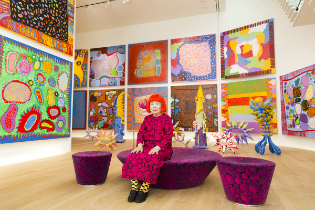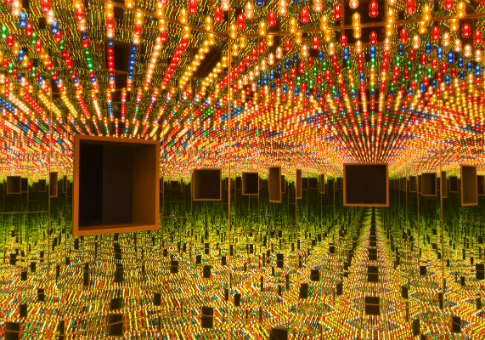Yayoi Kusama's "Infinity Mirrors" has been described as the most "selfie-worthy" art show touring North America. But Kusama's work is not necessarily pitched at the Instagram hordes who line up by the hundreds to witness her famous mirror-lined rooms. A picture—however many likes and shares it gains—cannot convey the mental afflictions that provoked each piece.
To get the artist's intended effect, it is best to enter the rooms she has built without a smart phone and ponder her themes of infinity, micro and macrocosms, immersion and emersion, death and life. The Hirshhorn's exhibit, assembled by the talented assistant curator Mika Yoshitake, opened on Thursday. Each ticket release sells out within minutes. It is the first time the Hirshhorn has provided timed tickets, as Kusama's rooms are meant to be entered by three people at most.
The famous Infinity Mirror rooms appear small on the outside, but as you walk inside along a polka-dot pathway, you find yourself gazing into the horizon of seemingly infinite space populated with floating lights or lanterns, meadows of glowing pumpkins, or fields of phallic, polka-dot tubers. The rooms' receding reflections provide a virtual reality meant to provoke transcendent, out of body experiences and, as art historian Jo Applin says, psychological disintegration.

"The effect of infinite, constant repetition leads us to finding our ever-expanding hope," Kusama says in a video at the beginning of the exhibit. "I have such a huge adoration of the concept of infinity and all of my creations come from that same foundation."
Kusama uses mirrors in an attempt to break away from physical limitations. Her use of virtual reality has been ahead of her time, never receiving the same attention as work by her pop art and minimalist contemporaries. Social media has helped her gain a wider audience, even if that audience shows up to get an impressive selfie rather than to experience fully her joyful and disturbing works.
What all of her patrons can agree on is that Kusama has an eccentric personality. She moved to New York from Japan in 1958 at the age of 29, searching for freedom of expression. Her life was already full of traumatic experiences, weighing her down with neurosis, fear of sex, and frequent hallucinations that inspired her repeating polka-dot patterns. For Kusama, the polka dot represents a slice of infinity. As she said, "Our earth is only one polka dot among a million stars in the cosmos."
Kusama only created deeply personal works. She confronted her fear of sex by meticulously making phallic tubers covered in polka dots—a lighthearted solution to a heavy problem. Her first Infinity Mirror room, Phalli's Field (1965), reflects polka-dot tubers into an endless field, and also presents a labor that for the artist was mentally and physically taxing. "I am terrified by just the thought of something long and ugly like a phallus entering me, and that is why I make so many of them," she wrote in an autobiography.
By immersing herself in her work, Kusama attempted to escape her fears and anxieties to achieve what she called "self-obliteration." The final room of the exhibit, The Obliteration Room, is not mirrored, but it is the most participatory. Patrons are given colorful polka dot stickers and are invited to obliterate the stark white room by placing them wherever they wish.

The Infinity Mirror rooms are funhouse-like, but they also carry the same eerie quality of her surrealist collages and drawings, some of which are presented in the exhibit. The room Aftermath of Obliteration of Eternity (2009) is filled with flickering lanterns refracted by black mirrors, recalling tōrō nagashi, a Japanese ceremony primarily invoked after World War II, where lanterns are lit and floated down a river to honor atomic bomb victims. The room expresses what Kusama sees as the space between nothingness and creation, similar to another room filled with twinkling lights, The Souls of Millions of Light Years Away (2013).
But Kusama's whimsically named room All the Eternal Love I Have for the Pumpkins (2016) shows that she also hopes to express joy and peacefulness through her work. "Pumpkins are humorous objects that also fill people with warm intentions," Kusama said. "That's what it means to have humor. Humor puts our minds at ease."
Kusama moved back to Japan in 1973 to check herself into a mental institution for her unrelenting neurosis, and she has remained there for over 40 years. But she never stopped creating art. Kusama's most recent works, a series titled My Eternal Soul, consist of vibrant paintings preceded by urchin-like sculptures whose spikes are covered in bright polka dots and swirling patterns. The works come together in a striking reflection of Kusama's current state, carrying themes of the courage to love oneself during depression and the anticipation of death.
Kusama's work has become unavoidable, a development that cannot be attributed solely to social media. Her name was already seeping into the artistic mainstream after multiple exhibitions in the United States, Europe, and Latin America, before social media brought her wider fame. Time named her one of its 100 Most Influential People in May 2016.
Kusama is more surprised by her new-found fame than anyone, Yoshitake said. She has no access to social media, and is pleasantly surprised that her work is reaching a new audience that wasn't even born when she returned to Japan.
"The young generation is in control of an enormous future, so I want them to fight with all their might to live a life just as big, filled with hope," Kusama says. "That is the message I want to relay to the younger generation."
Currently, the 87-year-old Kusama paints in her studio from 9 a.m. until dark, when she rests in order "to create something the next day." Kusama does not wish to impose her philosophy of self-obliteration and infinity on others, Yoshitake said. Instead, she hopes to evoke emotion through thought-provoking and humbling experiences.
"After I die," Kusama told Hirshhorn director Melissa Chiu, "I hope that people see that my paintings are about love and peace and spirituality. This is why I am painting. I keep on painting."
